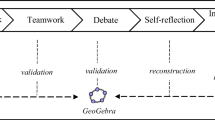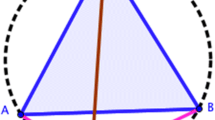Abstract
We focus on students’ mathematical reasoning in a technology-enhanced collaborative learning environment. We adopt a dialogical approach to analyze students' mathematical reasoning. The participants of this study include six middle school students. The data consist of participants’ written productions, dynamic materials, and the transcriptions of the participants’ discourse. The analysis shows that the integration of dynamic mathematics software into the ACODESA method contributes to their collective mathematical reasoning productively. The use of dynamic mathematics software as mediational artefacts and productive discussion as semiotic mediation are also required to enhance the participants’ both structural and process aspects of mathematical reasoning. The mediational role of dynamic mathematics software also helps them to make dynamic connection between mathematical reasoning and proving. In addition, participants’ representations evolve in the technology-enhanced learning environment and this evolution contributes to the development of mathematical reasoning.









Similar content being viewed by others
References
Albaladejo, I. R. M., García, M. D. M., & Codina, A. (2015). Developing mathematical competencies in secondary students by introducing dynamic geometry systems in the classroom. Education and Science, 40(177), 43–58.
Arzarello, F., Bartolini Bussi, M. G., Leung, A., Mariotti, M. A., & Stevenson, I. (2012). Experimental approach to theoretical thinking: Artefacts and proofs. In G. Hanna & M. De Villers (Eds.), Proof and proving in mathematics education: The 19th ICMI study (New ICMI Study Series) (pp. 97–137). Springer.
Bassey, M. (1999). Case study research in educational settings. Open University Press.
Bernabeu, M., Moreno, M., & Llinares, S. (2018). Primary school children’s (9 years-old) understanding of quadrilaterals. In E. Bergqvist, M. Österholm, C. Granberg, & L. Sumpter (Eds.), Proceedings of the 42nd conference of the international group for the psychology of mathematics education (vol. 2, pp. 155–162). Umeå: PME.
Bernabeu, M., Moreno, M., & Llinares, S. (2021). Primary school students’ understanding of polygons and the relationships between polygons. Educational Studies in Mathematics, 106(2), 251–270.
Brodie, K. (2010). Teaching mathematical reasoning in secondary school classrooms. Springer.
Burger, W. F., & Shaughnessy, J. M. (1986). Characterizing the Van Hiele levels of development in geometry. Journal for Research in Mathematics Education, 17, 31–48.
Carlsen, M. (2018). Upper secondary students’ mathematical reasoning on a sinusoidal function. Educational Studies in Mathematics, 99(3), 277–291. https://doi.org/10.1007/s10649-018-9844-1
Clements, D. H., & Battista, M. T. (1990). The effects of Logo on children’s conceptualizations of angles and polygons. Journal for Research in Mathematics Education, 21(5), 356–371.
Cobb, P., Wood, T., Yackel, E., & McNeal, B. (1992). Characteristics of classroom mathematics traditions: An interactional analysis. American Educational Research Journal, 29(3), 573–604.
Duval, R. (1995). Sémiosis et pensée humaine: Registres sémiotiques et apprentissages intellectuels [Semiosis and human thinking: Semiotic registers and intellectual learning]. Lang.
Duval, R. (1998). Geometry from a cognitive point of view. In C. Mammana & V. Villani (Eds.), Perspectives on the teaching of geometry for the 21st century (pp. 37–52). Kluwer.
Eriksson, H., & Sumpter, L. (2021). Algebraic and fractional thinking in collective mathematical reasoning. Educational Studies in Mathematics. https://doi.org/10.1007/s10649-021-10044-1
Falcade, R., Laborde, C., & Mariotti, M. A. (2007). Approaching functions: Cabri tools as instruments of semiotic mediation. Educational Studies in Mathematics, 66(3), 317–333.
Fujita, T. (2012). Learners’ level of understanding of the inclusion relations of quadrilaterals and prototype phenomenon. The Journal of Mathematical Behavior, 31(1), 60–72.
Hershkowitz, R. (1989). Visualization in geometry: Two sides of the coin. Focus on Learning Problems in Mathematics, 11(1 & 2), 61–75.
Hitt, F. (2011). Construction of mathematical knowledge using graphic calculators (CAS) in the mathematics classroom. International Journal of Mathematical Education in Science and Technology, 42(6), 723–735.
Hitt, F., & Dufour, S. (2021). Introduction to calculus through an open-ended task in the context of speed: representations and actions by students in action. ZDM Mathematics Education, 53(3), 635–647.
Hitt, F., & González-Martín, A. (2015). Covariation between variables in a modelling process: The ACODESA (collaborative learning, scientific debate and self-reflexion) method. Educational Studies in Mathematics, 88(2), 201–219.
Hitt, F., Saboya, M., & Cortés C. (2017). Task design in a paper and pencil and technological environment to promote inclusive learning: An example with polygonal numbers. In G. Aldon, F. Hitt, L. Bazzini & Gellert U. (Eds.), Mathematics and technology. A C.I.E.A.E.M. Sourcebook (pp. 57–74). Springer.
Hohenwarter, J., Hohenwarter, M., & Lavicza, Z. (2008). Introducing dynamic mathematics software to secondary school teachers: The case of GeoGebra. JI of Computers in Mathematics and Science Teaching, 28(2), 135–146.
Jeannotte, D., & Kieran, C. (2017). A conceptual model of mathematical reasoning for school mathematics. Educational Studies in Mathematics, 96(1), 1–16.
Kaur, H. (2015). Two aspects of young children’s thinking about different types of dynamic triangles: Prototypicality and inclusion. ZDM-Mathematics Education, 47(3), 407–420.
Kollosche, D. (2021). Styles of reasoning for mathematics education. Educational Studies in Mathematics. https://doi.org/10.1007/s10649-021-10046-z
Kontorovich, I., & Zazkis, R. (2016). Turn vs. shape: teachers cope with incompatible perspectives on angle. Educational Studies in Mathematics, 93(2), 223–243.
Krummheuer, G. (1995). The ethnography of argumentation. In P. Cobb & H. Bauersfeld (Eds.), Emergence of mathematical meaning (pp. 229–269). Lawrence Erlbaum.
Linell, P. (1998). Approaching dialogue: Talk, interaction and contexts in dialogical perspectives. John Benjamins.
Lithner, J. (2000). Mathematical reasoning in task solving. Educational Studies in Mathematics, 41(2), 165–190.
Mason, M. M. (1989). Geometric understanding and misconceptions among gifted fourth-eighth graders. In Paper presented at the Annual Meeting of the American Educational Research Association. San Francisco, CA.
Mata-Pereira, J., & Ponte, J. P. (2017). Enhancing students’ mathematical reasoning in the classroom: Teacher actions facilitating generalization and justification. Educational Studies in Mathematics, 96(2), 169–186.
McCrone, S. S. (2005). The development of mathematical discussions: An investigation in a fifth-grade classroom. Mathematical Thinking and Learning, 7(2), 111–133.
McMillan, J. H., & Schumacher, S. (2010). Research in education: Evidence-based inquiry (7th ed.). Pearson.
Miles, M. B., Huberman, A. M., & Saldana, J. (2014). Qualitative data analysis: A methods sourcebook (3rd ed.). Sage.
Moore, K. C. (2014). Quantitative reasoning and the sine function. Journal for Research in Mathematics Education, 45(1), 102–138.
National Council of Teachers of Mathematics [NCTM]. (2000). Principles and standards for school mathematics. Reston: NCTM.
Olsson, J., & Granberg, C. (2019). Dynamic Software, task solving with or without guidelines, and learning outcomes. Technology, Knowledge and Learning, 24(3), 419–436.
Peirce, C. S. (1956). Sixth paper: Deduction, induction, and hypothesis. In M. R. Cohen (Ed.), Chance, love, and logic: Philosophical essays (pp. 131–153). G. Braziller.
Radford, L. (1998). On culture and mind, a post-Vygotskian semiotic perspective, with an example from Greek mathematical thought. In Paper presented at the 23rd Annual Meeting of the Semiotic Society of America, Victoria College, University of Toronto, Canada. Retrieved Jan 25, 2019, from http://www.luisradford.ca/pub/102_On_culture_mind2.pdf.
Radford, L. (2003). Gestures, speech, and the sprouting of signs: A semiotic-cultural approach to students’ types of generalization. Mathematical Thinking and Learning, 5(1), 37–70.
Radford, L. (2008). Theories in mathematics education: A brief inquiry into their conceptual differences. ICMI 11 Survey team 7: The notion and role of theory in mathematics education research. Retrieved Dec 20, 2018, from http://www.luisradford.ca/pub/31_radfordicmist7_EN.pdf.
Reid, D. A. (2003). Forms and uses of abduction. In M. A. Mariotti (Ed.), Proceedings of 3rd Conference of European Society for Research in Mathematics Education (pp. 1–10). CERME.
Sfard, A. (2001). There is more to discourse than meets the ears: Looking at thinking as communicating to learn more about mathematical learning. Educational Studies in Mathematics, 46(1–3), 13–57.
Sfard, A. (2008). Thinking as communicating: Human development, the growth of discourses, and mathematizing. Cambridge University Press.
Sfard, A. (2012). Introduction: Developing mathematical discourse-some insights from communicational research. International Journal of Educational Research, 51–52, 1–9.
Tsamir, P., Tirosh, D., & Stavy, R. (1998). Do equilateral polygons have equal angels? In A. Olivier, & K. Newstead (Eds.), Proceeding of the 22nd conference of the international group for the psychology of mathematics education (Vol. 4, pp. 137–144). Stellenbosch.
Usiskin, Z. (2008). The classification of quadrilaterals: A study of definition. Information Age Publishing.
Zengin, Y. (2017). Investigating the use of the Khan Academy and mathematics software with a flipped classroom approach in mathematics teaching. Educational Technology & Society, 20(2), 89–100.
Zengin, Y. (2018). Examination of the constructed dynamic bridge between the concepts of differential and derivative with the integration of GeoGebra and the ACODESA method. Educational Studies in Mathematics, 99(3), 311–333.
Zengin, Y. (2019). Development of mathematical connection skills in a dynamic learning environment. Education and Information Technologies, 24(3), 2175–2194.
Zengin, Y. (2021). Construction of proof of the Fundamental Theorem of Calculus using dynamic mathematics software in the calculus classroom. Education and Information Technologies. Advance online publication.
Acknowledgements
This paper is based on the pilot study results implemented within the context of the first author's master thesis.
Author information
Authors and Affiliations
Corresponding author
Additional information
Publisher's Note
Springer Nature remains neutral with regard to jurisdictional claims in published maps and institutional affiliations.
Appendix 1: A sample part of the tasks
Appendix 1: A sample part of the tasks
Asli goes to the volleyball training in her school every weekend. After the warm-up exercises in the training, firstly, overhand pass drills are performed. In the training, the students are lined up on the ground of the schoolyard to stand on the circle drawn beforehand. The teacher stands in the middle of this circle. Students should stand at equal physical space to each other so that they do not hinder each other’s movements and thus they move freely.
In the training, the teacher said, “After the warm-up, we move on to the overhand pass drills. In this training, everyone must throw the ball to their friend, who is right next to them. You will learn how to pass the ball at a short distance.” According to this.
-
(a)
What kind of shape do you think can emerge if the passing drill that the teacher talks about is created geometrically?
-
(b)
Considering that you are watching the students’ passing model from a bird’s eye view, how can you create this model in GeoGebra?
-
(c)
Show the pattern of passing model that can occur according to the different number of students.
-
(d)
What are the characteristics of the remaining shape if the circle is removed from this model you have created?
-
(e)
What are the side lengths of the resulting shapes? Relate the side lengths and the angles formed between these sides.
-
(f)
Support your arguments in GeoGebra software.
Rights and permissions
About this article
Cite this article
Aksu, N., Zengin, Y. Disclosure of students’ mathematical reasoning through collaborative technology-enhanced learning environment. Educ Inf Technol 27, 1609–1634 (2022). https://doi.org/10.1007/s10639-021-10686-x
Received:
Accepted:
Published:
Issue Date:
DOI: https://doi.org/10.1007/s10639-021-10686-x




